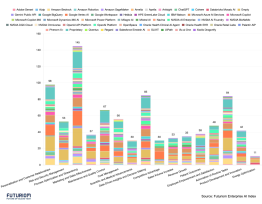What to Watch in NVIDIA's Earnings: Blackwell, China, and Margins

All eyes are on NVIDIA, the epicenter of the AI boom. NVIDIA reports tonight in what feels like a “show me” moment for the industry, which has pumped up the level of hype and market valuations to the number 11, even if you can find some doubts about the lofty expectations of the AI boom.
NVIDIA currently has a market capitalization of $4.4 trillion, which is astounding within itself, making it the most valuable company in the world. The company is approaching $200 billion in annual sales at its current run rate. The stock is trading at about 30 times next year’s earnings, which isn’t terribly expensive relative to its profit and growth, but its price/sales ratio of 30X sales does make the eyes bulge a little.
The bottom line is that there is little room for disappointment. Most of Wall Street’s sell-side analysts remain eminently bullish on NVIDIA. The company has issued a revenue forecast of $46 billion for the second quarter, but Wall St. consensus has it delivering $50 billion or more, and many “whisper numbers” creep as high as $52 billion. Enormous expectations are built into the stock. I would expect that the stock would go higher only on a substantial beat, but look for a selloff on anything short of a big beat.
All Eyes on Blackwell and Hon Hai (Foxconn)
To get a grasp of what NVIDIA might hold for investors and the industry, you should look carefully at what NVIDIA says about Blackwell and China, with Blackwell being the most important.
Blackwell is NVIDIA’s next-generation chip and systems architecture, which is being prepped in production now and expected to ramp sales in the fourth quarter. Recent Wall St. buzz is focused on how NVIDIA’s contract manufacturer partners are progressing with shipments of NVIDIA’s highest-end chips and systems, which include the GB200 and GB300 AI clusters, based on the Blackwell GPU.
Of particular interest is the Taiwanese manufacturer Hon Hai Precision Industry Co., known by its common trade name, Foxconn. Hon Hai is the world's largest contract electronics manufacturer. Once famous as being the primary contract manufacturer for the iPhone, it’s now a massively diversified enterprise that makes everything from cables to AI racks.
Here’s the rub: While Hon Hai has recently been issuing bullish forecasts for the Blackwell generation as well as other AI systems, other contract manufacturers such as Quanta and Wistron have been dialing back forecasts. So what’s actually going on?
This may seem a bit “inside baseball” to some, but contract manufacturers are very important. They are the engines that put all the pieces together and deliver the final products to customers.
'Freaking Out' About Quanta?
According to an investment note I recently saw from Jefferies, AI infrastructure bulls were recently “freaked out” by somewhat soft guidance from contract manufacturers Wistron and Quanta. Everyone is watching how these manufacturers progress in the pilot stage of producing NVIDIA’s Blackwell cluster racks, which have been subject to some delays. Although Quanta has reaffirmed its plans to deliver ramping sales this year, there are initial indications, based on Quanta’s guidance, that this may not be ramping as fast as the market has indicated.
The GB200, which is shipping now, is another important area to watch for new AI infrastructure demand. Jefferies estimated that Wistron’s GB200 shipment volume has been lower than expected, at 500-600 racks in July instead of 700-800 racks. But the Jefferies note also says that Wistron is “progressing faster than its peers on the GB300.”
Hon Hai, in comparison, has been sending stronger signals to the market. Hon Hai has guided for 7,000-8,000 racks of GB200 for fiscal year 2025.
What About China?
Another area of interest for NVIDIA investors is China. After an export ban reversal in July 2025 by the U.S government, NVIDIA and AMD are licensed to sell lower-tier AI chips in China, but with a new 15% revenue-sharing deal for the US government.
While some believe this could add billions to NVIDIA’s revenue as NVIDIA resumes shipments of the H20 chip, this seems speculative. Recently, the Chinese government has sent mixed signals about whether it even wants NVIDIA chips, and the proposed 15% revenue-sharing with the U.S. government could be seen as a tax as well as an increased nationalization of the AI chip industry. Given the recent U.S. move to take a position in Intel, this should give China pause. China has expressed a strong will to develop its own AI chips to diversify away from U.S. manufacturers, given the growing tensions in trade.
Some other risks to NVIDIA's China strategy include security warnings from the Chinese government, as well as the rise in competitive offerings from Chinese manufacturers.
Margins, Networking Need to Stay High
Whatever the revenue number is, Wall St. analysts and investors might be more interested in NVIDIA's margins. One of NVIDIA's unique positions is that it ships complicated, proprietary systems with integrated networking and software. This gives its products and solutions high status and also delivers unheard-of margins in the hardware systems industry. NVIDIA's gross margins regularly exceed 70%. To compare, the nearest competitors would be Cisco and Arista, which have recently printed gross margins in the mid-sixties.
Because so much of NVIDIA's stock value is based on its competitive position—it is the undisputed leader in AI systems—its high margins and leadership comprise a large premium in its stock price. Any sign that competitors are making progress in AI systems will first show up in a decrease in margins and spook investors.
Futuriom Take: This quarter's report from NVIDIA is critical to the entire industry to get a read on the sustainability of the AI boom. It also bears watching for NVIDIA's progress in shipping Blackwell-based AI clusters, as well as any sign of growing threats from competitors such as AMD.



















